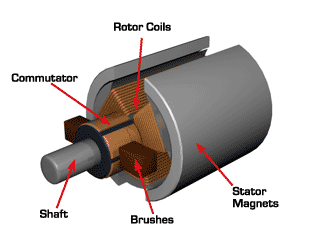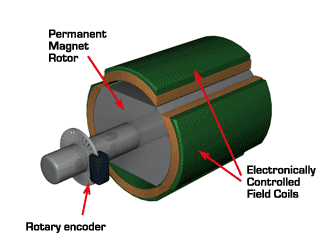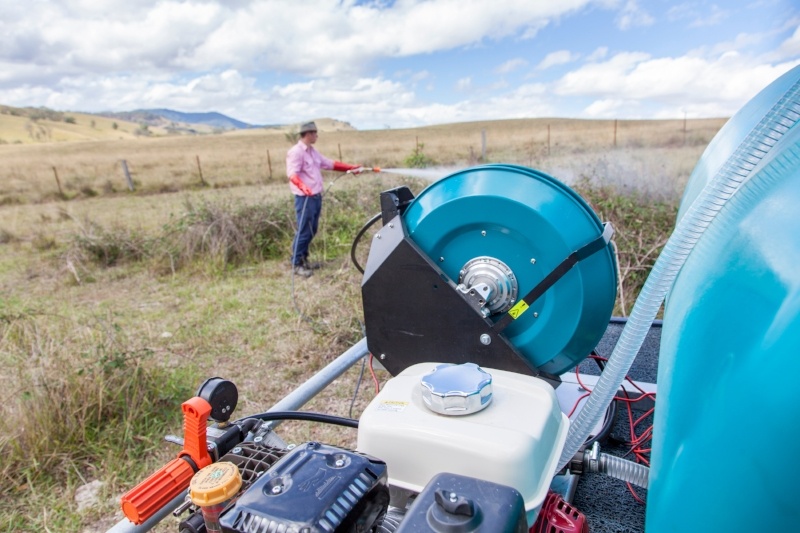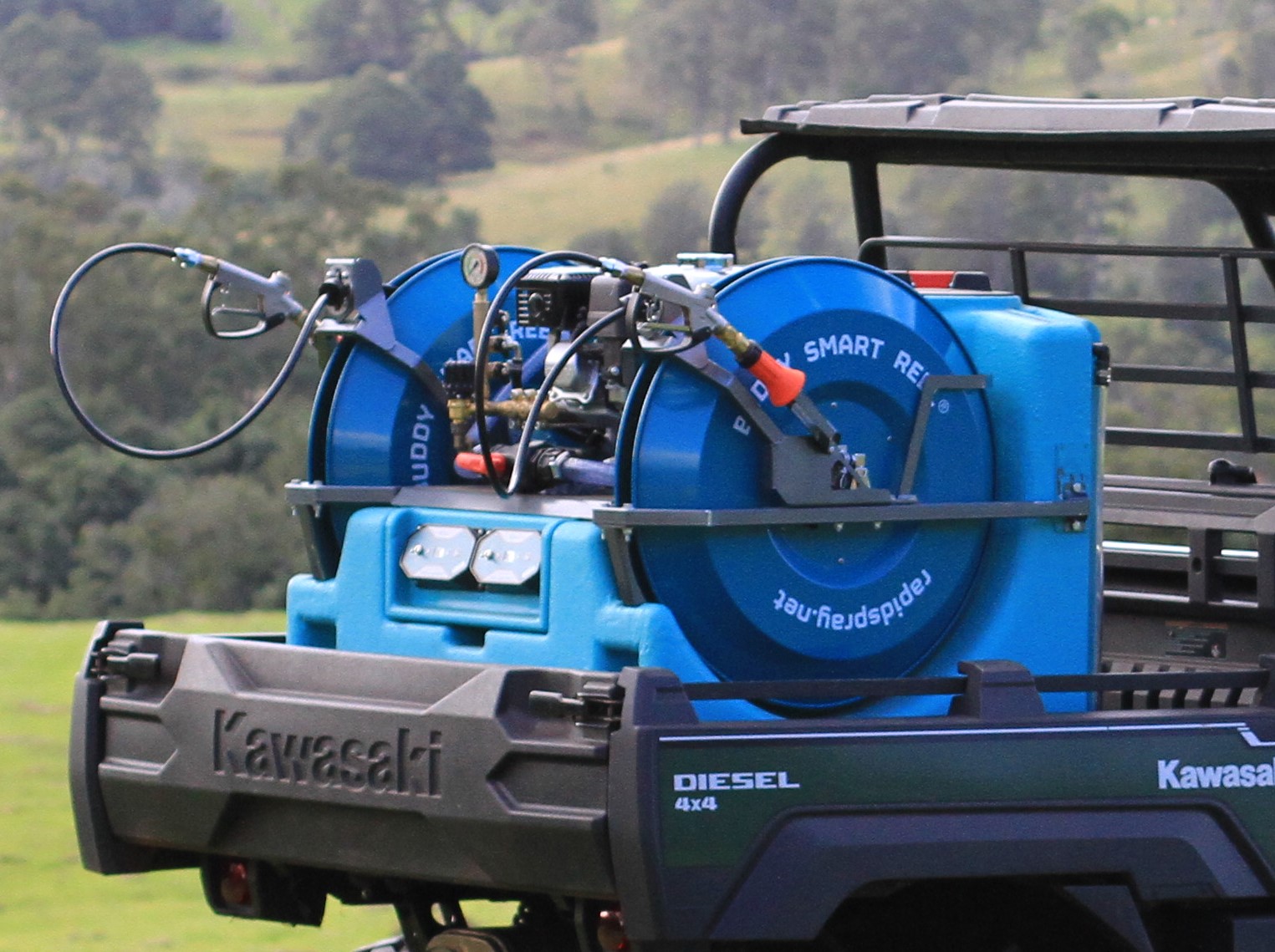Remote controlled spray hose reels, otherwise known as auto reels, power reels or back savers - call them what you like - are a 'must-have' for anyone serious about spraying.
Once considered a luxury tool only for the cashed-up contractor or ratepayer funded council, auto reel sprayers are surging in popularity with farmers, land care groups, parks & wildlife and councils all over Australia, New Zealand and beyond.
Most remote controlled reels now utilise a 12 or 24 volt DC (direct current, like from a car battery) electric motor to wind the hose up. While this is pretty neat in itself, the really brilliant part is that you don't even need to walk back to the reel to operate the unit. You can be 150m away (that's one and a half footy fields), at the far end of the hose and press a button a small remote in your hand, and hey presto, the hose neatly winds in, and you find yourself ready to get straight back into the cab and move on.
Electric remote controlled hose reels can come with two different types of motor - brushed or the newer brushless motor (AKA smart motors, BLDC or EC motors). While they both achieve a similar result, there are distinct differences in how they operate, how long they last and their ease of use. Both types of motors cause a rotating movement to happen to make the reel wind up your hose, however some motors operate directly on the hose reel while other motors work with belts and pulley's, or chains to rewind the hose spool.
By now you are probably wondering about these new fangled brushless motors, are they just a marketing gimmick, what makes them better than a brushed motor and are there really any differences between them? Don't guess yet, but it definitely has nothing to do with the way they are painted!
To clear the air, brushless motors are definitely NOT a marketing gimmick. The motors operate quite differently from their brushed cousins, and have a number of very legitimate and unique advantages.
So how does a DC motor work?
The DC motor, whether brushed or brushless, uses a combination of permanent and electric magnets to make them spin. Do you remember (maybe many years ago) when you had a bunch of magnets and you would try to push a N magnet end against another N magnet end what happened? They tried to push each other away, and when you let go, they spun around as quick as a cat and stuck the opposite ends together? (we haven't forgotten when it managed to pinch your skin!)
This same principle is responsible for making DC motors work.
So what is the difference between brushed and brushless motors, and how do they work?
How does a brushed motor work?
In brushed motors, the power goes through two brushes made of little blocks of carbon/graphite, like the centre of a 2H pencil. There is a brush on each side of the motor shaft (like in the image below). These brushes are pushed by springs (not shown in the image) to physically contact (rub against) the part called the "commutator". The commutator is a series of copper plates wrapped around the shaft and selectively (similar to a set of ON/OFF switches) transfer the electric current from the brushes to the next part of the motor called the rotor coil (or armature). The armature is copper wires wrapped tightly around some steel sections fixed to the shaft to make electromagnets. On the outside of the motor (normally glued to the inside of the motor case), are some fixed N and S (permanent) Stator magnets. When power is connect to the rotor, the electro magnets come to life and react with the fixed magnets and start spinning. And that's what makes the motor shaft go around!

| ADVANTAGES |
DISADVANTAGES |
| Cheaper as they don't require an electronic control circuit | The friction of the brushes inside a brushed motor causes power loss and overheating |
| The soft brush material wears down due to friction, creating dust, and eventually, the brushes will need to be replaced | |
| Sealing of the motor can only be achieved at the expense of proper cooling, as the electric windings (get very hot) are not in contact with the motor case | |
| Potentially hazardous sparks (similar to an old electric drill) | |
| Can cause radio interference (not great on a radio controlled hose reel!) | |
| A single fixed speed determined by voltage | |
| Apply full power constantly, even if not required (flattening your battery quicker) | |
How does a brushless motor work?
In the previous brushed explanation above, the rotor coils (armature) were fixed to the shaft and the N and S magnets were fixed to the stationary outside of the motor. In a brushless motor, these are swapped around. The armature, now called field coils, is now on the stationary outside of the motor and the N and S permanent magnets are attached to the spinning shaft. Without the carbon brushes (hence the term brushless), how does the brushless motor deal with the electricity to create the opposing magnetic fields? This is where brushless motors become a bit more complex and costly. An extra bit of electronic circuitry is essential to make a brushless motor work. This electronic circuit replaces the brushes and commutator found on the brushed motor. When combined with some form of rotary encoder, this circuit controls the switching of the field coils to react with the N and S permanent magnet rotor, causing the shaft to spin.

| ADVANTAGES |
DISADVANTAGES |
| More powerful, though same size as brushed motor | Usually cost more as they have an electronic circuit |
| Have increased reliability through reduced moving/wearing parts | |
| Reduced noise and longer lifetime (no brush or commutator erosion) | |
| Sparks are eliminated (no commutator) | |
| Stay cooler as the field windings are in contact with the motor case | |
| Motors internals can be entirely enclosed and protected from dirt and water | |
| Can vary the speed, using the existing electronic switching system (Making variable speed control like 'My-Pace' possible) | |
| Automatically senses the load and adjusts the power output to suit (doesn't waste unnecessary power) | |
| Can be used for position control via the existing electronic switching system and rotary encoder | |
The numerous benefits of brushless motors are fast seeing them replace not only brushed motors in many applications such as power tools and home appliances, but also in the traditional combustion engine in machines such as cars, garden tools and even airplanes.
So back to the question, are brushless motors really the best option for remote controlled hose reels?
While there are distinct mechanical and electrical benefits from brushless motors over their traditional brushed cousins, there are additional benefits for remote controlled hose reels. One of these is the ability to 'embed' the motor within the spool and 'direct drive' the hose reel, eliminating belts, pulleys or chains which in turn reduces maintenance and complexity.
An extremely user friendly feature of brushless motors is the ability to control their speed allowing you to rewind the hose at different speeds. The Buddy Smart Reel 'My-Pace' remote control includes this function allowing operators to select their preferred rewind speed with a simple press of a button.
With brushless motors taking over many everyday applications, make sure your next remote control hose reel is using a brushless motor for maximum reliability and minimum maintenance.




